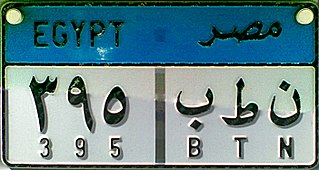Australian vehicle registration plates or number plates are issued by state, territory, and Commonwealth governments, and the armed forces of Australia. The plates are associated with a vehicle and are generally intended to last for the time the vehicle remains registered in the state, though as they become unreadable they may be recalled or replaced with newer ones. Motor vehicle registration in Australia requires to be renewed annually with the payment of the registration fee.

All motorised road vehicles in India are tagged with a registration or license number. The Vehicle registration plate number is issued by the district-level Regional Transport Office (RTO) of respective states — the main authority on road matters. The number plates are placed in the front and back of the vehicle. By law, all plates are required to be in modern Hindu-Arabic numerals with Latin letters. Other guidelines include having the plate lit up at night and the restriction of the fonts that could be used. In some states such as Sikkim, cars bearing outside plates are barred from entering restricted areas. The international vehicle registration code for India is IND.
Vehicle registration plates of Poland indicate the region of registration of the vehicle encoded in the number plate.
Finnish vehicle registration plates usually carry three letters and three numbers separated with a dash, though vanity plates may carry just one of each. Since 1989 the code has no connection with the geographic location, except that Åland has its own type of plate. Between 1972/1973 and 1989 the first letter indicated where the vehicle was first registered as the plate did not have to be changed even if the vehicle was moved to another area of Finland.

A metal or plastic plate or plates attached to a motor vehicle or trailer for official identification purposes. The registration identifier is a numeric or alphanumeric code that uniquely identifies the vehicle within the issuing authority's database. In Europe most countries have adopted a common format for number plates, such as the common EU format issued in EU member states. This format satisfies the requirements in the Vienna Convention on Road Traffic, which states that cross-border vehicles must display a distinguishing code for the country of registration on the rear of the vehicle. This sign may be an oval sticker placed separately from the registration plate, or may be incorporated into the vehicle registration plate. When the distinguishing sign is incorporated into the registration plate, it must also appear on the front registration plate of the vehicle, and may be supplemented with the flag or emblem of the national state, or the emblem of the regional economic integration organisation to which the country belongs.
Vehicle registration plates in Hungary usually consist of six characters on white background with black letters. The current system was introduced in 1990. The standard license plates for private vehicles carry three letters and three numbers, separated with a hyphen. The combination has no connection with geographic location.
In New Zealand, vehicle registration plates contain up to six alphanumeric characters, depending on the type of vehicle and the date of registration. To be operated on any public road, most types of motor vehicles and trailers must be registered and display the corresponding registration plate(s). One plate must be affixed to the rear of the vehicle, and except in the case of a motorcycle, moped, tractor, or trailer, a second plate must be affixed to the front of the vehicle.
Maltese registration plates are the number plates used within Malta to uniquely identify motor vehicles. Since 1995, the three letter, three number system has been in use in Malta for vehicle registration. The characters are always printed in black on a white background, and to the left one can find a blue box with the Flag of Europe and the letter M underneath it in white. The typeface used on Maltese registration plates is FE-Schrift which is also the typeface used on German vehicle registration plates.
Standard Bulgarian vehicle registration plates display black glyphs on a white background, together with – on the left-hand side of the plate – a blue vertical "EU strip" showing the flag of Europe and, below it, the country code for Bulgaria: BG.
Vehicle registration plates of Serbia are issued using a two-letter region code, followed by three or four-digit numeric and a two-letter alpha license code, separated by a hyphen.
As of the year 2017 there are two different valid systems of vehicle registration plates in the Czech Republic.

Belarusian vehicle registration plates are currently composed of four digits, two letters and another digit. The first of the letters and the final digit indicate the region of Belarus in which the car was registered.
Vehicle registration plates of Estonia are divided into 18 categories, the most common of these (A1) is composed of three numbers and three letters. Most registration plate types have black letters on a white background, and the plates are the same size and length as other European plates. Previously the first of the three letters indicated the region of Estonia in which the car was registered; however, as of 2013, this is no longer the case. The third digit from the numbers indicated states when the car is due an inspection. It can be inspected up to 2 months after that digit. The registration plates are printed on an aluminium sheet with minimum thickness of 1 mm and must fulfil the requirements of ISO 7591:1982. All plates are issued with the blue European Union identification label, except types A9 and B2.
An Israeli vehicle registration plate, or an Israeli license plate, is a vehicle registration plate, a metal or plastic plate or plates attached to a motor vehicle or trailer, used in Israel for official identification purposes.

Egyptian vehicle registration number plates are license plates used for official identification purposes for motor vehicles in Egypt.

Vehicle registration plates of Saudi Arabia are manufactured by Government Printing Press in Riyadh. Saudi Arabia has taken action to ensure that all people residing within its borders register their vehicles in Saudi Arabia and display a rear as well as a front license plate.

Vehicle registration plates are the mandatory alphanumeric plates used to display the registration mark of a vehicle, and have existed in the United Kingdom since 1904. It is compulsory for motor vehicles used on public roads to display vehicle registration plates, with the exception of vehicles of the reigning monarch used on official business.
Kyrgyz registration plates were first issued in 1980, when the country was still a republic of the Soviet Union. Despite having gained its independence in 1991, it continued to use the old Soviet plates until the introduction of the current format in 1994.
Vehicle registration plates, commonly known as number plates, are the mandatory alphanumeric or numeric plates used to display the registration mark of a vehicle.









